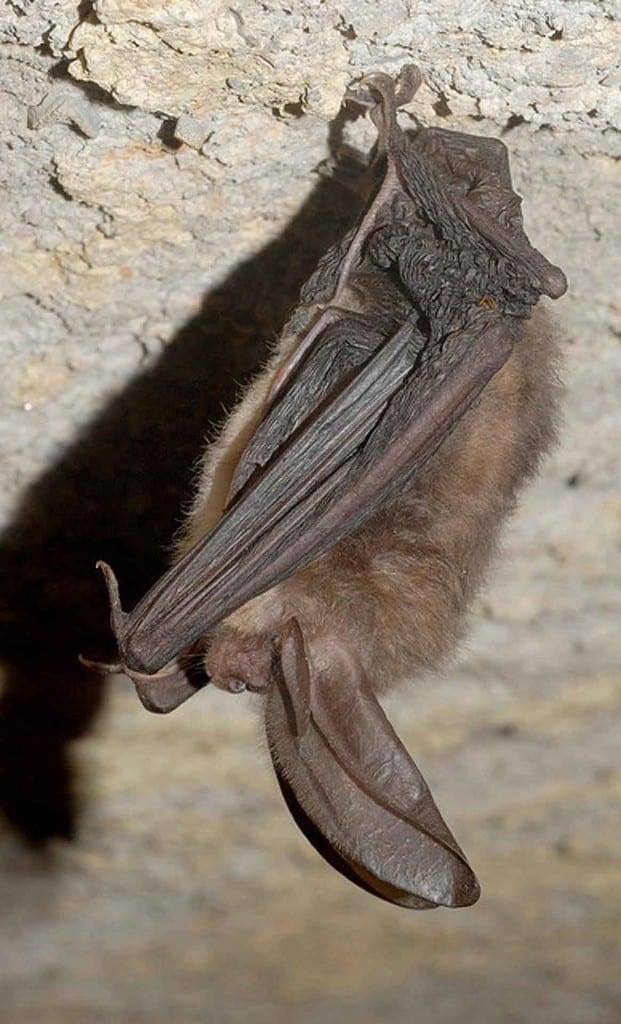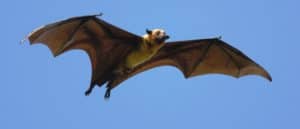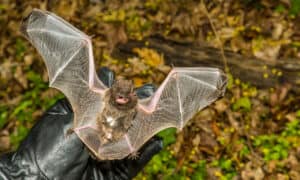The intriguing and ominous Hellhole Cave is in Germany Valley, Pendleton County. Home to two endangered bat species and many hibernating bat colonies, this unique pit cave is an important ecological site and area of research. In this guide, we’ll delve into Hellhole Cave, meet the bats who live inside, and discover what scientists are learning about one of the most ecologically significant caves in West Virginia.
Read on to learn more.
Discover Hellhole Cave
Hellhole Cave is privately owned. Only cavers involved in monitoring, researching, and protecting the bat populations that reside within can enter. To access the Hellhole, researchers must enter through the only currently known entrance- a funnel-shaped pit with a 154-foot drop. The bottom of this pit is a vast, impressive chamber. It gives way to a now documented 40-plus miles of passages.

The only entrance to Hellhole Cave drops 154 feet to the chamber’s floor.
©Dave Bunnell / CC BY-SA 4.0 DEED – License
Limestone Formation
Hellhole’s passages primarily consist of limestone layers. Specifically, the type of limestone that exists throughout the cave is New Market limestone. It consists of a dense, fine-grained structure. New Market limestone is highly valuable commercially and the reason for several open pit limestone mining operations near the cave.
A Struggle for the Fate of Hellhole Cave
Since the late 1980s, a struggle for the fate of Hellhole Cave has ensued between the Greer Limestone Company and environmental activists. While the limestone company sought to expand its nearby mining operations, environmentalist cavers fought to gain access to mapping the cave system.
Unfortunately, Greer Limestone Company gained leased control of the cave’s pit entrance in 1986. It quickly moved to halt most access to the cave. The exception is for twice-yearly trips to monitor bat populations. Since endangered bat populations exist in the cave, the Endangered Species Act of 1973 should protect the site from mining operations. What Greer Limestone likely sought to do by refusing most access to the cave was prevent further mapping that would extend the known area of the cave system and, therefore, extend the areas unable to be mined.
Starting in the 1990s, the company permitted limited surveying after years of pressure from environmental organizations and dedicated activists. In 2002, after years of activism, the Germany Valley Karst Survey was granted access to map the entirety of the cave. This provided much more robust protection to Hellhole Cave and its inhabitants.
Discover Hellhole Cave: The Endangered Bats
Currently, Hellhole Cave is home to two populations of endangered bats. The Indiana bat (Myotis sodalis) and the Virginia big-eared bat (Corynorhinus townsendii virginianus) hibernate here. Approximately 40% of the world’s Virginia big-eared bat population, of which there are only about 15,000 left in the world, spend their winter hibernation in Hellhole Cave. Before 2010, the population count of hibernating Indiana bats was 13,000, the largest concentration in the state.
Hellhole is a vital hibernation site (hibernaculum) for these endangered bats due to its low ambient air temperature compared to other West Virginia caves. While other WV caves average about 57 degrees Fahrenheit, Hellhole hovers around 47 degrees, making it an ideal hibernaculum.

The Virginia big-eared bat is one of two federally endangered species that hibernate in Hellhole Cave.
©Public Domain – License
White Nose Syndrome
Tragically, in late 2009, researchers announced evidence of white-nose syndrome (WNS) in Hellhole Cave. This fungal infection targets the noses of many species of bats. It rouses them from their hibernation and leaves them weak and vulnerable to starvation. This devastating disease kills 70-90 percent of bats in an affected hibernaculum. In some areas, white-nose syndrome has wiped out entire colonies numbered in the hundreds of thousands. While the Virginia big-eared bat appears unaffected by WNS, scientists fear the loss of up to 90% of Hellhole Cave’s Indiana bat population.
Additionally, about 200,000 bats of various species hibernate in Hellhole Cave. This makes the site one of the eastern U.S.’s most important bat hibernation caves. Of the 200,000 individuals, approximately 100,000 little brown bats (Myotis lucifugus) hibernate here and are highly affected by WNS. A 2010 survey of Hellhole revealed infection clusters of Indiana bats between 12-50%. A current estimation of the cave’s Indiana bat population has sadly dropped from 13,000 to below 9,000.
Readers interested in bat conservation can help fight white-nose syndrome by donating to research efforts cleaning shoes and gear before and after entering caves. Do not enter closed caves or disturb any sleeping bats you may find during a caving trip.

Sadly, in late 2009, researchers documented the existence of white-nose syndrome in Hellhole Cave. Thankfully, the disease does not appear to infect the critically endangered Virginia big-eared bat. However, it has tragically ravaged populations of little brown bats (pictured) and the endangered Indiana bats.
©Public Domain – License
The photo featured at the top of this post is © Ondrej Prosicky/Shutterstock.com
Thank you for reading! Have some feedback for us? Contact the AZ Animals editorial team.






